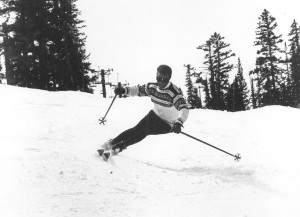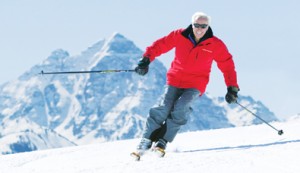Last week, I wrote about how stretch pants helped increase skiing’s popularity during the 1950’s and 1960’s. Indeed in-the-boot stretch pants were an integral part of the skiing “uniform” worn during that era.
The upper body portion of the uniform consisted of several visible – or actually partially visible – layers. First there was the turtleneck usually made of cotton, then over the turtleneck was a windshirt, then over the windshirt was a ski sweater, and then finally a parka.

Stein Eriksen in Uniform
In addition to warmth there was another logical reason for this approach: on warm days you could take off your parka and ski in just your sweater! Never mind that the forecast for the day was a high of zero with 30 mile-per-hour winds, you still put on your uniform. Who knows? The sun could suddenly come out, the winds could die, and the temperature could rise above freezing, then you were ready!
I believe the inspiration for the uniform came from Stein Eriksen. Many of us grew up wanting to “Ski like Stein” and every picture showed him skiing in a sweater. So to ski like Stein meant skiing in your sweater whenever possible.
The uniform also influenced where you placed your lift ticket. If you might end up skiing in your sweater then you couldn’t attach the lift ticket to your parka. So you devised creative places to fasten your lift ticket. I ruined at least one ski sweater by repeatedly hooking ticket wickets to it.
Let’s take a closer look at some of the components in the uniform.
Much like stretch pants, ski sweaters became fashionable. So with the uniform you just took off your parka and you were ready for the après ski gathering. You could even wear your ski sweaters to non-skiing events and be in fashion.
The turtleneck had been around since the 15th century. They became more fashionable in the early 1950’s during the Beat generation and skiers took advantage of the combination of fashion and function. Turtlenecks were typically made of cotton which by today’s standards was not a good choice. Once they got wet whether from sweat or snow, they stayed wet.

Klaus Obermeyer
Last week, Peter Penndorf correctly identified Klaus Obermeyer as the person who created the first nylon windshirt. Obermeyer started the clothing company that bears his name and can claim many other firsts in ski clothing including the quilted down parka.
Klaus moved from Germany to Aspen in 1947 where he still lives and skis at the age of 91. In an interesting twist of fate, last week Klaus made the news when he broke his leg while skiing at Buttermilk Mountain in Aspen. He vows to ski again once he recovers.
As mentioned, the windshirt was worn under your ski sweater in the original uniform. However in the late 1960’s and early 1970’s, windshirts became very colorful and often used psychedelic patterns. These demanded to be seen so skiers started wearing them over their sweaters and this led to the end of the “uniform” as many of us knew it.
There was also one item that wasn’t part of the uniform: a hat! Check out any picture you’ve ever seen of Stein Eriksen and he never wore a hat. Even today at the age of 84 he still doesn’t wear a hat! (And he still has a full head of hair.)
Now I know Stein spent some time at Sugarbush so there were days when he must have needed a hat. Anyway, any time you were able to ski in just a sweater you also took off your hat.

Leave a Reply